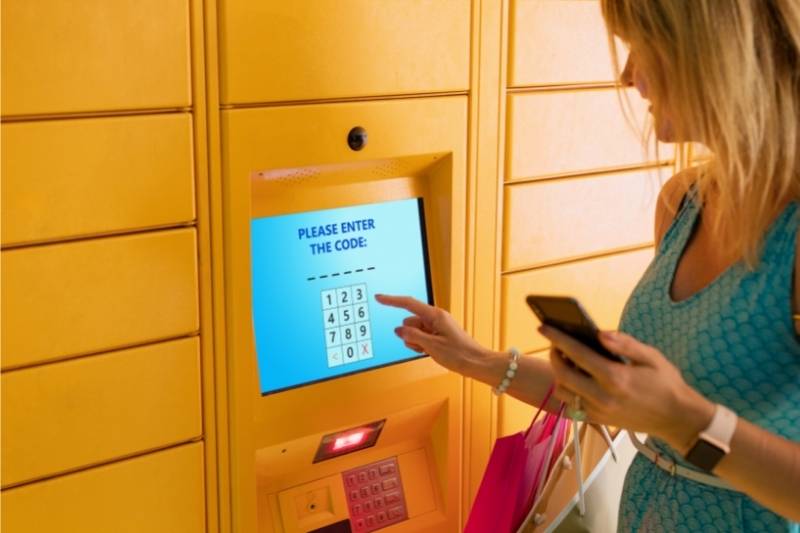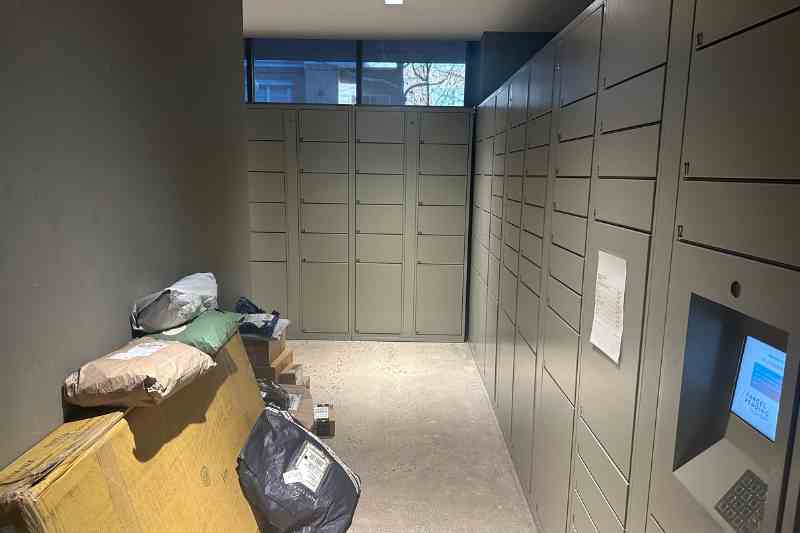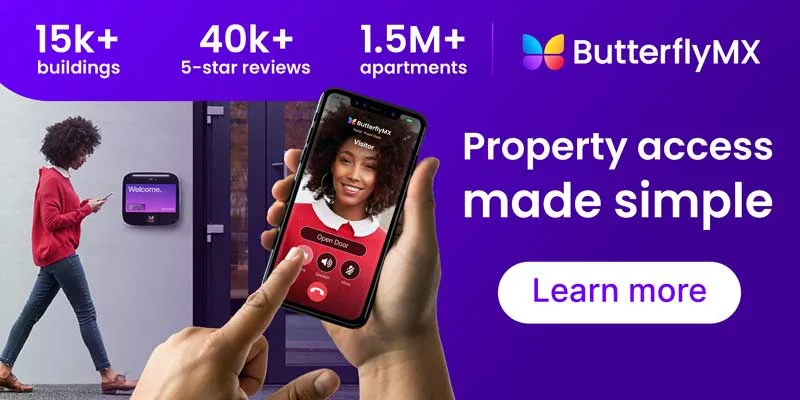Key takeaways:
- Smart locker systems are secure containers where delivery carriers can leave packages for residents.
- The primary way smart lockers work is by utilizing smart technology to electronically lock. In turn, they can only be opened with a valid credential, such as a PIN or QR code.
- Smart locker systems are beneficial because they cut down on package theft and don’t require hands-on package management. Their cons include not accommodating larger packages and a big price tag.
- A package room is better than smart lockers because they’re more inclusive in the packages they accommodate, are more affordable, and offer more security options.

The 2020s are the age of smart everything — and smart locker systems are no exception. As the name suggests, smart lockers are the next evolution in apartment building package storage for residents.
More people than ever order packages and goods online — thanks to Amazon and grocery delivery services like Instacart. What’s more, reports of package theft are on the rise all over the country. So, ensuring that your property can protect your residents’ packages is extremely important. And smart locker systems are one potential solution.
However, smart lockers might not be best for your multifamily property. Read this guide to learn everything you need to know about the best package lockers, including how they work and how much they cost. You’ll also learn the pros and cons of smart locker software and your best alternatives.
This guide covers:
- What are smart locker systems?
- What is the technology behind smart lockers?
- Types of smart lockers for apartments
- Use cases for smart lockers
- Pros and cons of a smart locker solution
- The best alternative to a smart locker system
- Smart locker FAQs
What are smart locker systems?
Smart lockers are secure storage systems that contain a computer and sensors to automate the package delivery and pickup processes. While they may be used as a temporary storage facility — for example, for travelers to store luggage during a long layover — smart lockers are primarily used as a package delivery system for multi-tenant buildings.
Smart lockers are secure places where mail carriers can leave packages behind a locked door to ensure successful deliveries and prevent package theft. While they’re most prevalent in multifamily properties, smart lockers can also be used in commercial buildings. Smart lockers for offices streamline deliveries for tenants and their employees.
You’ll usually find smart lockers in the lobby or in the front of a building. Package delivery people use a digital code to unlock compartments in a locker system and drop off packages. Overall, smart lockers may reduce package theft and “sorry we missed you” slips from mail carriers.
The components of a smart locker system are:
- Cubbies. The locked compartments where packages are stored. Couriers unlock a compartment by entering an access code and scanning a package. Then, after they place a parcel inside a cubby, it locks automatically.
- Smart locker software. The software makes a smart locker ‘smart.’ It powers the locker system’s user interface, which allows couriers to enter a digital code to unlock compartments and securely deliver packages. The software also allows building staff to upload a tenant directory and assign access codes to carriers. Finally, the smart locker’s software sends automated notifications — by text, email, or mobile app — to residents when they receive a delivery.
How much do smart lockers cost?
Smart locker prices vary anywhere from about $5,000 to $21,000 on average. However, keep in mind that these prices don’t include possible installation costs or ongoing service fees.
What is the technology behind smart lockers?
Smart lockers allow delivery carriers to enter a digital code to open locker compartments electronically. They then place parcels in the lockers to ensure secure deliveries. As a result, property staff members don’t have to manage deliveries manually, and residents can pick up their packages from the smart parcel lockers anytime.
Here’s the process of using a smart locker system:
- A courier enters an access code at the locker, which usually has a touchscreen or otherwise digital interface.
- The courier scans each package and marks which resident each parcel is for.
- After placing a package in a locker, the courier shuts the door, which locks automatically.
- Then, the smart package locker system sends an automated notification with a unique PIN or QR code to each resident who receives a delivery. The notification could be a text, an email, or an app notification if the system comes with a mobile app.
- Residents use their QR code or PIN to unlock the correct locker compartment and retrieve their packages.
Watch how the ButterflyMX package room works:
What are the components of a smart locker solution?
Hardware components:
- Storage compartment. This is the small cubicle where packages are stored.
- Locking mechanism. Locks engage electronically once the storage compartment is closed.
- Authentication panel. Residents and delivery personnel use this electronic panel (that either features a touch screen or physical buttons) to use their entry credentials to disengage the locking mechanism.
Software components:
- User management system. Allows you to create, manage, and authenticate user accounts to ensure secure access to lockers.
- Access control software. Manages who can access specific lockers and when, integrating with PIN codes, RFID cards, or mobile apps.
- Reservation and scheduling system. Enables users to reserve lockers in advance and schedule pick-up or drop-off times.
- Notification system. Sends alerts via SMS, email, or app notifications to inform users of locker availability, access status, or overdue items.
- Payment processing system. Facilitates payment collection for rented lockers or additional services through secure online transactions.
- IoT device management software. Ensures seamless communication between lockers, sensors, and connected devices for real-time updates.
- Maintenance and monitoring system. Detects malfunctions or usage anomalies to ensure timely maintenance.
Are smart lockers safe?
Yes, the best smart lockers are reasonably safe.
Tens of millions of Americans have at least one package stolen every year. Smart lockers help keep packages away from prying eyes. They are extremely difficult to break into without a code, and there is no readily available way to hack them or pick the lock.
However, some valid safety concerns are:
- An unauthorized person acquiring a courier’s or a resident’s access code.
- Couriers opt out of using the lockers and instead leave packages out in the open.
Types of smart lockers for apartments
The most common types of smart lockers are:
- Parcel delivery lockers. Automated parcel lockers receive and hold packages securely. They’re commonly used in apartments, student housing, and corporate offices for contactless package delivery and retrieval.
- Refrigerated and temperature-controlled lockers. Equipped with cooling or temperature regulation features to store groceries, meal deliveries, medications, or other temperature-sensitive items.
- Click-and-collect lockers. Used in retail settings for online order pickups, allowing customers to retrieve purchases at their convenience. These electronic parcel lockers streamline the buy-online, pick up in-store (BOPIS) process.
- Personal storage lockers. Used in workplaces, call centers, gyms, and schools for employees or students to safely store personal belongings like bags, electronics, and valuables.
- Laundry lockers. Designed for dry cleaning or laundry services. These lockers allow tenants to conveniently drop off and pick up clothes in residential or corporate environments.
- Battery charging lockers. Include built-in charging ports for devices like laptops, tablets, and phones, commonly used in libraries, corporate offices, airports, and student housing.
- Return and exchange lockers. Enable seamless product returns or exchanges, particularly in retail or e-commerce settings.
- Medical and pharmacy lockers. Securely store and distribute medications, lab samples, or medical equipment, with temperature control or access monitoring as needed in hospitals and healthcare facilities.
Explore the differences between a package room and a package locker:
Use cases for smart lockers
Here are some common applications for apartment smart lockers:
- Accountancy and law firms. Smart lockers securely store sensitive client documents and files, providing authorized employees with safe, easy access while maintaining confidentiality. They also streamline document exchanges with clients by enabling contactless pickups and drop-offs.
- Financial institutions. Banks and financial offices use smart lockers to securely hold sensitive paperwork, cash deposits, or confidential client materials.
- Corporate offices. Smart lockers facilitate package deliveries, personal item storage, and IT equipment management in hybrid or large workplaces.
- Apartments. In multifamily buildings, smart lockers provide a secure, contactless solution for package deliveries, ensuring residents can access their deliveries 24/7.
- Warehouses. Smart lockers store tools, equipment, and inventory for easy retrieval by authorized workers.
- Hospitals. Hospitals use smart lockers to securely store medications, medical equipment, and staff belongings, ensuring compliance with regulations while streamlining access for authorized personnel.
- Retail stores. Smart locker software enables click-and-collect services for online orders, allowing customers to pick up purchases at their convenience.
- Student housing. Smart lockers provide a secure and convenient solution for package deliveries and personal item storage so that students can access their belongings anytime.
Pros & cons of a smart locker solution
Apartment smart lockers are a decent package delivery system compared to the alternative: forcing staff to manually manage deliveries or leaving packages out in your building’s lobby.
So smart locker technology is certainly a step up, but is it good enough?
Pros of smart lockers:
- They’re available 24/7 for residents to access. So residents can pick up packages at any time.
- They offer a form of contactless delivery through a smart locker app.
- They save time for staff, who won’t have to handle the package intake and storage process.
- Residents can use their phones to unlock them.
- They help deter porch pirates.
Cons of smart lockers:
- Compartment size can be really restrictive. Big or odd-shaped packages such as TVs and furniture will not fit, so they’re left in the open.
- There’s no surveillance process monitoring who accesses the lockers.
- They’re bulky and take up a lot of space in your building.
- Smart lockers are expensive and require a huge upfront investment.
- Many delivery carriers ignore package lockers and opt to leave packages at the front desk, by the front door, or in the lobby instead. This defeats the purpose of installing lockers and leaves parcels susceptible to theft.
- Smart lockers don’t have built-in building access control features. So, if the lockers are in your building’s lobby and your front door is locked, couriers will have trouble accessing them.

The best alternative to a smart locker system
A package room is the best alternative to a smart locker. Instead of a series of cramped cubbies that won’t fit boxes of all sizes, why not give residents a whole room protected by advanced security features?
Package rooms do everything that smart lockers do but better. They guarantee a resident 24/7 access to their packages. Residents can also operate them entirely from their phones, and they prevent package thieves.
Here’s why package rooms are better than smart lockers:

1. Ample storage space
These days, people order everything from furniture to groceries online. So, many parcels are oversized or oddly shaped. Additionally, many residents also have multiple packages delivered in one day — and when you’re managing deliveries during the holiday season, this number multiplies even more.
As a result, you need a package management solution that provides ample storage space. Unfortunately, smart lockers limit deliveries to the size of the largest compartment. In contrast, a package room can accommodate parcels of all shapes and sizes.
2. Scalability
A package room is more accommodating to the ever-changing nature of your building’s residents. For example, a single smart locker might be enough for an individual or couple who live in your building’s units, but if that unit’s occupancy reaches three or four, a smart locker might not be able to accommodate their packages.
In contrast, a package room is endlessly customizable for tenants. When you set up a package room, you can easily add or remove shelves or move them around to accommodate your building’s needs at any time.
3. More affordable
As opposed to investing up to $21,000 on individual lockers for your building, package rooms are substantially more affordable. All you really have to worry about purchasing is a video access control system that secures the room and some shelving to help manage and organize packages.
Additionally, instead of worrying about maintenance costs for multiple lockers, you’ll only have one system to keep up to date.
4. Easy installation
Package rooms are also easy to set up. All you have to do is add shelving, ensure that the room has electricity and an internet connection, and install a video intercom at the entryway to control access. From here, you can also opt to install additional video surveillance within the room for added security. That way, you can monitor activity as needed.
Still trying to decide between a package locker and a package room solution?
Comparing smart lockers vs. package rooms:
Smart locker FAQs
Here are some commonly asked questions about smart lockers:
- Are USPS smart lockers free?
- How do I pick up a package from a USPS parcel locker?
- How much does it cost to make a locker?
Are USPS smart lockers free?
Yes, USPS parcel lockers are free to use for recipients. They are typically part of the USPS delivery process for oversized packages or multiple deliveries in residential or commercial buildings.
How do I pick up a package from a USPS parcel locker?
To pick up a package from a USPS parcel locker:
- You’ll receive a key or access code in your mailbox or via notification.
- Locate the designated parcel locker (marked with the corresponding locker number).
- Use the key or enter the access code to unlock the parcel locker and retrieve your package.
- For lockers with a key, leave the key in the lock after removing your package.
How much does it cost to make a locker?
The cost to make a smart locker depends on factors like size, material, features, and technology integration. Basic smart lockers may start at $1,000 to $2,000 per unit, while advanced lockers with temperature control, IoT integration, and cloud management can range from $5,000 to more than $10,000, depending on customizations and requirements.







